
Two mature trees in habitat, elev. 3450 m, near Chitkul, Himachal Pradesh, India [Gaurav Verma, 2020.10].
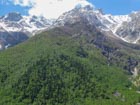
A stand of A. gamblei shows dark against a forest of mostly Betula utilis; there is also common Pinus wallichiana, esp. at lower elevations. The A. gamblei occupies a relatively stable north-facing habitat on lower spur ridges, while adjacent valleys are more often disturbed by flood and avalanche. Location is near Chitkul, Himachal Pradesh, India [Gaurav Verma, 2016.06].
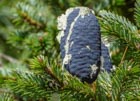
Nearly mature cone on a tree near Chitkul, Himachal Pradesh, India [Gaurav Verma, 2020.10].

Foliage with vegetative buds on a tree near Chitkul, Himachal Pradesh, India [Gaurav Verma, 2020.10].
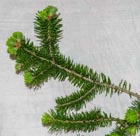
Foliage, upper side, collected near Chitkul, Himachal Pradesh, India [Gaurav Verma, 2018.06].

Foliage, lower side, collected near Chitkul, Himachal Pradesh, India [Gaurav Verma, 2018.06].

Bark on a mature tree near Chitkul, Himachal Pradesh, India [Gaurav Verma, 2020.10].
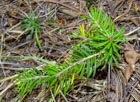
Seedling 3-4 years old near Chitkul, Himachal Pradesh, India [Gaurav Verma, 2020.10].
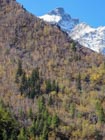
A small stand of A. gamblei in a forest of Betula utilis; the lighter green conifers are Pinus wallichiana. Near Chitkul, Himachal Pradesh, India [Gaurav Verma, 2020.10].

Conservation Status

Abies gamblei
Hickel 1929
Common names
Gamble fir, west Himalayan alpine fir (Debreczy and Rácz 2011).
Taxonomic notes
Syn. Abies pindrow (Royle ex D. Don) Royle var. brevifolia Dallim. & A.B. Jacks. 1923; A. pindrow subsp. gamblei (Hickel) Rushforth 1999. Although molecular studies have not been done yet, several lines of evidence suggest that this taxon is quite distinct from A. pindrow. In areas where both species occur, they are at substantially different elevations (A. gamblei subalpine, A. pindrow montane). In such areas there are no intermediate forms, no evidence of hybridization or introgression, even though these things are generally common in sympatric populations of closely-related Abies taxa. There are also consistent morphological differences; A. pindrow has some of the longest needles of any Abies, while those of A. gamblei are unusually short; also the twigs are different colors (yellowish vs. gray). The placement of this species within Abies is uncertain, but Rushforth (1987) grouped it with A. pindrow while admitting it "is a bit of an enigma" and noting a close resemblance to A. × vasconcellosiana, an artificial hybrid between A. pindrow and A. pinsapo; the latter is also a short-needled fir of relatively cool, dry sites. So about all we can say with confidence is that it seems to be intermediate between the Himalayan and Mediterranean firs, which collectively represent all of the Old World sections of Abies. Conceivably, it is of hybrid origin.
Description
Trees to 30 m tall and 100 cm dbh with a conical crown, becoming thin or irregular in old trees. Bark smooth, brownish-gray, darkening with age, becoming stiff-platy and ridged. Twigs glabrous, color uncertain (one source says light yellowish gray, darkening with age; another says purple or orange-brown, graying with age). Buds ovoid, blunt, resinous, 4-10 mm. Leaves on shade foliage pectinate, spreading, in 2 to 3 layers, 10-37 mm long, dark green with one or a few lines of adaxial stomata, and most stomata in 2 whitish abaxial bands; apex rounded to emarginate. Sun foliage radially arranged on the shoot. Pollen cones lateral, 3-4.5 cm long (the largest of any Abies), yellow at maturity. Seed cones erect, on lateral brachlets, 6-10 × 4-5 cm, cylindrical-ovoid, maturing purplish or grayish-blue, bluish bracts included; rachis thick. Seeds not described (Debreczy and Rácz 2011, Rushforth 1987, Philippe de Spoelberch 2021).
Compared to other Himalayan firs, distinctive characters relatively short needles that are flat or broadly V-shaped in cross-section, and stomata on upper needle surface.
Distribution and Ecology
India: Himachal Pradesh; also, perhaps, "western Nepal westward to eastern Afghanistan" (CAW 2017, but i can't find evidence supporting this assertion). Found in the "drier parts of the Himalyas" (drier than what, is unclear) on carbonate substrates at 3000-3500 m elevation, commonly with Picea smithiana, Pinus wallichiana, Taxus contorta, Betula utilis, and Quercus semecarpifolia. Where found near A. pindrow, it consistently occurs at substantially higher elevations, sometimes up to the treeline, with no intermediate forms suggesting introgression with A. pindrow (Debreczy and Rácz 2011, CAW 2017).
The conservation status of this variety has not been assessed by the IUCN, which regards A. gamblei as synonymous with A. pindrow. The conservation assessment for A. pindrow itself ("Least Concern") is questionable due to its age (2010) and its rationale that the the species has a wide distribution, which has been achieved by lumping separate taxa together. Moreover, the IUCN assessment notes that the species is protected in few reserves. It seems likely that, if assessed under IUCN criteria, A. gamblei would be at least "Vulnerable".
Remarkable Specimens
I have no data for trees in habitat, though the photos shown here suggest heights to about 20 m and diameters to about 70 cm dbh. Monumental Trees (2021) lists one ornamental specimen in Scotland, measured in 2014, with a girth of 3.50 m (114 cm dbh). The tree has lost its top, but was about 13 m tall before that happened in 2007.
Ethnobotany
No data as of 2023.02.22.
Observations
No data as of 2023.02.22.
Remarks
The epithet refers to James Sykes Gamble (1847-1925), English botanist, who specialized in the regional flora of India and Indochina (Hickel 1929).
Citations
CAW. 2017.08.10. CAW's Blog, Abies Gamblei - Gamble Fir. https://conifersaroundtheworld.com/blog/abies-gamblei-gamble-fir, accessed 2021.02.14.
Hickel, R. 1929. Les sapins de l'Himalaya, Abies Gamblei spec. nov. Bulletin da la Société Dendrologique de France 68:38.
Rushforth, Keith D. 1987. Conifers. New York: Facts on File (p. 76).
Rushforth, Keith D. 1999. International Dendrological Society Yearbook 1998:63.
See also









